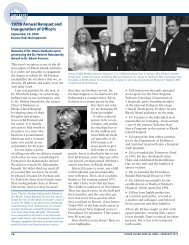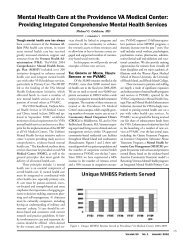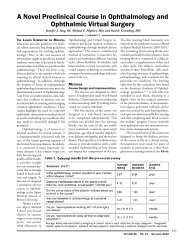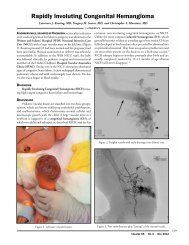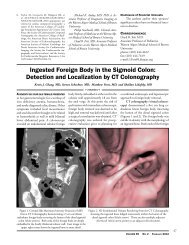Hyperuricemia & Gout - Rhode Island Medical Society
Hyperuricemia & Gout - Rhode Island Medical Society
Hyperuricemia & Gout - Rhode Island Medical Society
Create successful ePaper yourself
Turn your PDF publications into a flip-book with our unique Google optimized e-Paper software.
<strong>Medical</strong> Implications of <strong>Hyperuricemia</strong><br />
Larissa Sachs, MD, Kerri L. Batra, MD, and Bernard Zimmermann, MD<br />
<br />
WHAT IS HYPERURICEMIA?<br />
Uric acid is an oxidation product of<br />
purine metabolism, which in primates (including<br />
humans) is largely eliminated by<br />
the kidney and the gut. Most non-primate<br />
mammals express uricase, an enzyme that<br />
converts serum uric acid into allantoin,<br />
which is easily excreted by the kidneys. Nonprimate<br />
mammals thus usually have low<br />
serum uric acid (SUA) levels (below 2 mg/<br />
dl), while primates have the potential to<br />
develop hyperuricemia, because they lack<br />
uricase. In humans, renal under excretion<br />
of uric acid is the cause of 90% of hyperuricemia,<br />
while 10% is due to overproduction<br />
of uric acid. Uric acid is more toxic to<br />
tissues than other purine metabolites such<br />
as xanthine, hypoxanthine and allantoin.<br />
<strong>Hyperuricemia</strong> is defined as a serum<br />
urate level greater than 6.0 mg/dl in<br />
women, and 7.0 mg/dl in men. Above<br />
this concentration, urate is supersaturated<br />
in body fluids, and is prone to crystallization<br />
and subsequent tissue deposition. The<br />
rising prevalence of hyperuricemia over<br />
the last several decades can be attributed<br />
to several factors. Westernization of diets<br />
and widespread use of high-fructose syrup<br />
may play a role in increasing SUA levels. 1<br />
Other factors that might be involved include<br />
increased lifespan and more common<br />
use of certain medications, including<br />
diuretics and cyclosporine. The prevalence<br />
of asymptomatic hyperuricemia in<br />
US is estimated to be 5-8 % among adult<br />
Caucasian men and it is even more common<br />
in some ethnic groups, such as<br />
Philippinos and Polynesians.<br />
While a few studies have noted a potential<br />
beneficial antioxidative effect of uric<br />
acid and even suggested a neuroprotective<br />
role, most studies link hyperuricemia with<br />
such co-morbidities as hypertension, renal<br />
disease, metabolic syndrome and cardiovascular<br />
disease (CVD).<br />
gout. The duration of each stage varies significantly<br />
among individuals. (Table 1)<br />
Fewer than one-third of individuals<br />
with asymptomatic hyperuricemia will develop<br />
gouty arthritis. The risk of developing<br />
gout increases with age and the degree<br />
of hyperuricemia. In the Normative<br />
Aging Study, the 5-year cumulative incidence<br />
of gout among those with a uric acid<br />
level between 7.0 and 8.0 mg/dl was 3%,<br />
compared to 22% in those with a uric acid<br />
level of 9.0 mg/dl. 2 (Figure 1)<br />
Acute gouty arthritis occurs when uric<br />
acid crystals interact with synovial phagocytes,<br />
which in turn activate neutrophils<br />
and initiate an inflammatory cascade. Urate<br />
crystals that serve as a trigger for an acute<br />
attack may derive from preformed synovial<br />
deposits or precipitate in the joint de novo.<br />
Clinically, acute gout presents with rapid<br />
onset of a painful, erythematous and swollen<br />
joint that may be accompanied by fever.<br />
Inflammation of the first metatarsophalangeal<br />
joint (also known as podagra), is the<br />
most characteristic presentation but other<br />
joints are often involved.<br />
Intercritical gout is the name given<br />
to the asymptomatic interval between<br />
acute attacks. In early gout, intercritical<br />
periods may last for years, but with progression<br />
of the disease the time between<br />
attacks tends to lessen.<br />
Chronic tophaceous gout is characterized<br />
by the development of tophi in and<br />
around the joints, which can cause destructive<br />
arthritis. (Figure 2) Tophi are commonly<br />
found in the soft tissues, including<br />
tendons, pinnae and subcutaneous fat.<br />
Tophi have been reported in such unusual<br />
locations as heart valves, spinal cord,<br />
sclerae, breast and even Cushing’s striae.<br />
Table 1. Stages of <strong>Hyperuricemia</strong> and <strong>Gout</strong>.<br />
Stage Duration Clinical Features<br />
Asymptomatic >10-15 years Asymptomatic<br />
hyperuricemia<br />
Acute gout 1-2 weeks Sudden onset of acute<br />
mono- or oligoarthritis<br />
(e.g., podagra)<br />
Intercritical gout From weeks Asymptomatic intervals between<br />
to years<br />
acute attacks<br />
Chronic tophaceous 10 or more years Development of tophi in and<br />
gout after the first episode around the joints and soft<br />
of acute gout tissues<br />
HYPERURICEMIA AND GOUT<br />
The most well known medical manifestation<br />
of hyperuricemia is gout. <strong>Gout</strong> is<br />
caused by deposition of uric acid crystals in<br />
and around the joints and has 4 stages: asymptomatic<br />
hyperuricemia, acute gout,<br />
intercritical gout, and chronic tophaceous<br />
Figure 1. Cumulative Incidence of <strong>Gout</strong>y Arthritis by Prior Serum Urate Levels.<br />
The numbers refer to the number of examination intervals for each group. Reprinted from<br />
American Journal of Medicine, 1987 March 82(3); Campion EW, Glynn RJ, DeLabry LO.<br />
Asymptomatic hyperuricemia. Risks and consequences in the Normative Aging Study.<br />
Pages: 421-6 Copyright 2009, with permission from Elsevier.<br />
VOLUME 92 NO. 11 NOVEMBER 2009<br />
353




